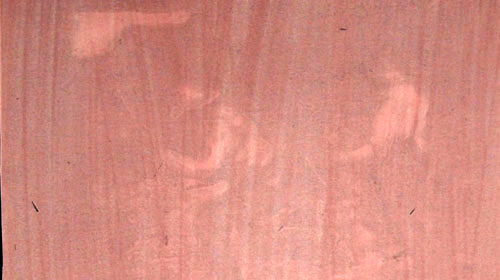It seems quite likely that my mother-in -law, Mien Thissen-Mulder, found this book while browsing in the second-hand shop where her sister Doortje volunteered. It is called ‘De schilderkunst der XIXe eeuw’, (painting of the 19th century) written by Léonce Bénédite, curator of the Musée de Luxembourg, its date 1910. And, as was her habit, she must have asked her daughter, my wife, “do you think Stijn has any use for this?’ I haven’t seen it for a long time but now that I started this blog I’m glad I kept it because it offers many interesting starting points.
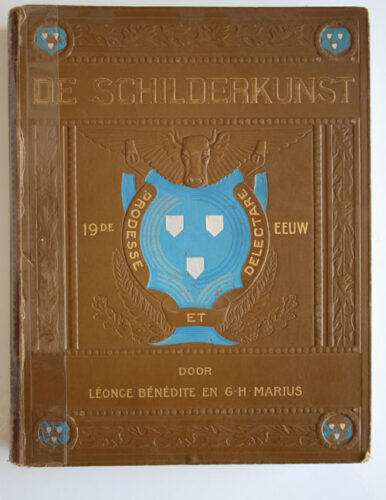
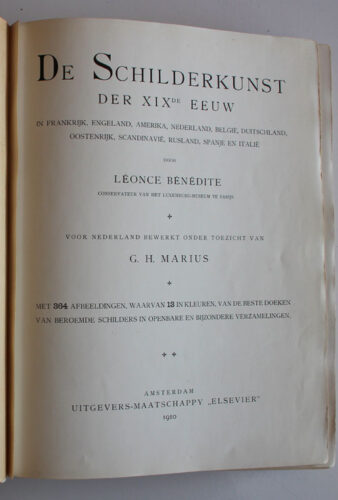
The Paris Bibliotheque Nationale is the keeper of ‘Courbet, Gustave (1819-1877) Critique et interprétation’ a biography and critical essay written by Léonce Bénédite. I intend to translate it from the French and read it because I’m curious about the content. I will come back to that later on. If you want to read it already you can find it here;
https://gallica.bnf.fr/ark:/12148/bpt6k5516489g/texteBrut
Curioser and curiouser
Curioser and curiouser I get ( thank you Lewis Carroll ! ) by reading this fragment from an article by Oliver Larkin, titled; ‘Courbet and his contemporaries, 1848-1867’ (Science & Society,Vol. 3, No. 1 (Winter, 1939), pp. 42-63)
“Because Courbet was so long a prophet without honor in his own country, a large proportion of his work is owned by museums and collectors outside France. Many phases of his career, notably his activities during the Commune, are still imperfectly understood. Before 1900 scarcely a single French art journal of repute cared to publish material on the painter. Belatedly in 1919, when New York’s Metropolitan Museum was honouring the centenary of his birth, France bought the Atelier for seven hundred thousand francs. Two years later, Léonce Bénédite was invited to represent the State at the unveiling of a tablet placed on Courbet’s birthplace at Ornans. The curator of the Luxembourg declined to attend the ceremony on the ground that he had “received counter-instructions”.
This is a page from my book.
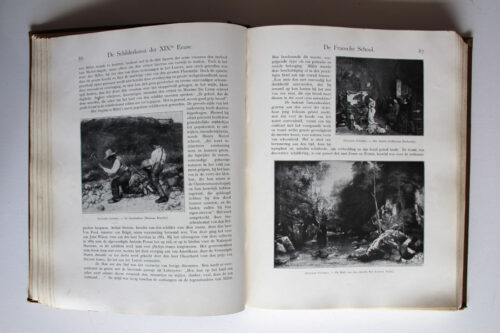
The Studio
The caption under the reproduction of ‘The Studio’ still gives Collection Desfossés as its owner, and the caption under ‘the Stonebreakers simply mentions Museum, Dresden. The enlarged image shows that an error occured, it is the wrong painting. This, mirrored, version is today in the Collection Oskar Reinhart, Winterthur.
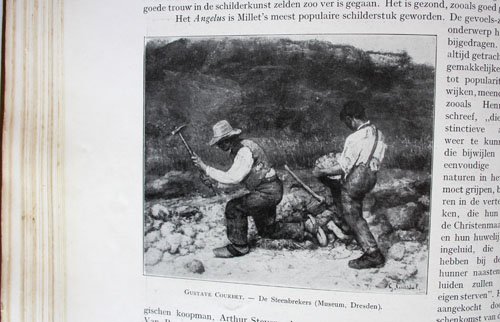
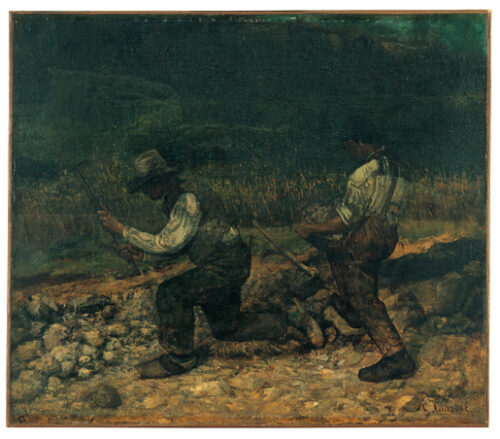
But it looks like a very different painting when I study the reproduction on the site of the Oskar Reinhart Collection. It seems to have darkened almost beyond recognition. Time and the use of bitumen in the paint have done their work. Courbet painted it in 1849, the book for publishing house Flammarion was produced in 1905, the work was possibly photographed at the time that the painting was 55 years old.
And now the painting’s age is 169 years, so the discoloration took place over a period of 110 years. The effects of bitumen are common knowledge and many of Courbet’s works fade into darkness, an extra stimulant is his preference to work on dark tinted canvases.
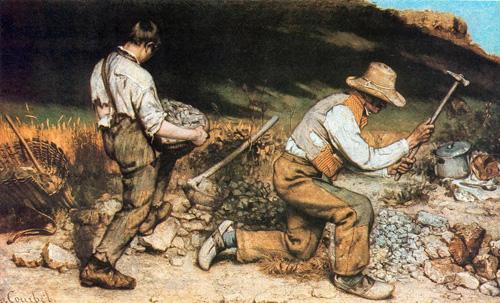
This is the painting from the Dresden Museum collection. Together with 154 other paintings it was loaded in februari 1945 into a van and on transport from the Zwinger Museum in Dresden to Königstein Castle (The King’s Rock). In times of conflict this was a well known practice. The castle offered sufficient protection. But the road did not, the danger came from above. The transport was bombed by Allied planes.
December of 2017 I was offered a working period in a guest studio of the Vincent van GoghHuis in Zundert. I was able to go deep into van Gogh’s work and his engagement , and made a lot of painted monotype prints on the small etching press I brought along. After you have printed the image, the printing plate still shows a shadow of it on which you can react again with ink. Degas was very accomplished in this technique. I was fascinated to try out one of the possibilities I hadn’t experimented with and that was the ‘black manner’. With ink you cover the whole surface of the printing plate and start working back from dark to light by using brushes, cloth, sticks and fingers to delve up the image. It is a slow and time-consuming manner of working resulting in just one ‘good’ print. To start with I chose a reproduction of ‘the Stonebreakers’, the lost Dresden version.
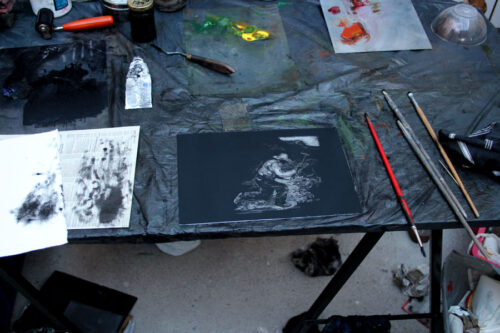
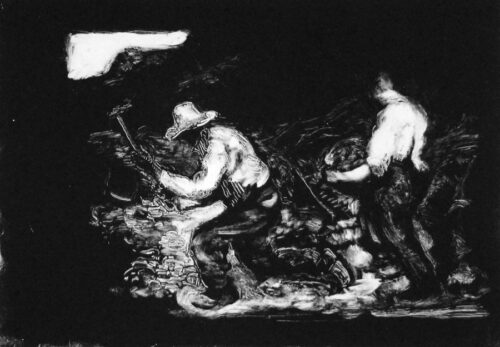
The first fully inked print. And without adding any more ink to the plate I made three more prints on pink tinted paper, gradually losing more and more of the image.
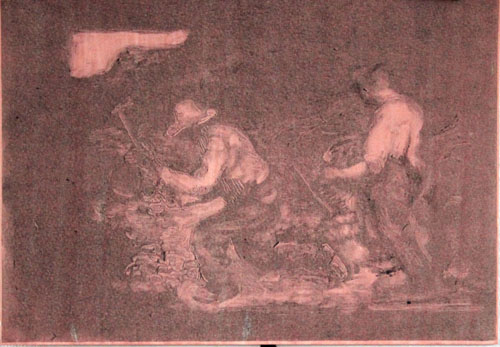
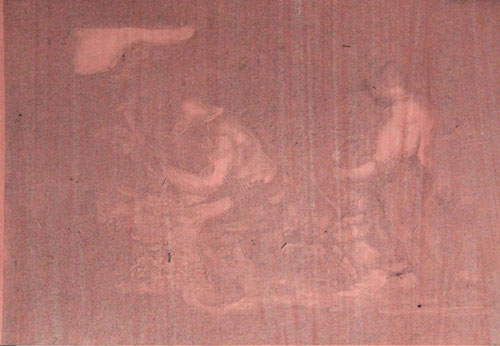
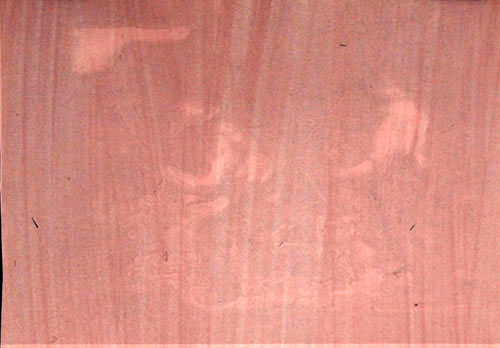
Stijn Peeters 2018.
